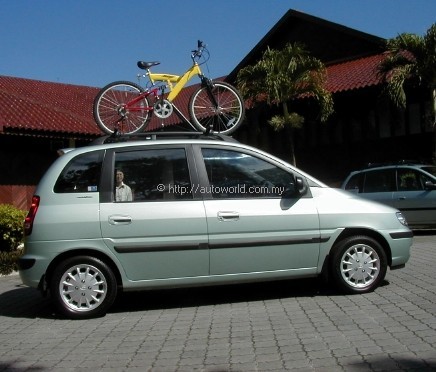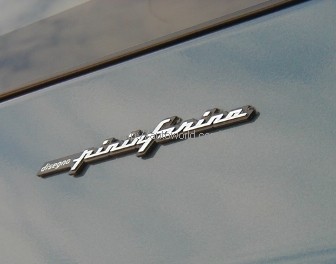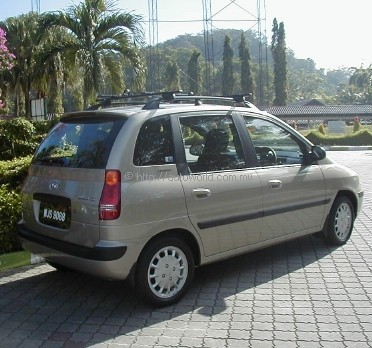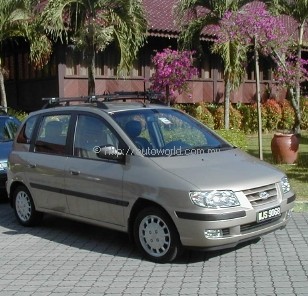Hyundai Matrix Expected to Big Hit
Hyundai-Berjaya Sdn Bhd today provided the local media with a preview of the new Hyundai Matrix MPV which has been attracting a good deal of attention. The model was introduced in Korea a year ago and has been a strong seller in Europe, delaying its introduction here.
“The Matrix has been very well received in Europe and our allocation is low for the time being,” explained Ben Yeoh, Executive Director of Hyundai-Berjaya, the marketing arm of Hyumal Sdn Bhd which is the official franchise holder for Hyundai vehicles in Malaysia. He added that the special specifications for the Malaysian units also added to the delay.
Mr Yeoh said that he expects that there will be at least 3,000 Malaysians who will want to buy the Matrix this year but due to limited supply from Korea as well as limited numbers of APs (import permits), the actual number sold won’t be as much.
“If possible, we hope to sell at least 700 units this year which will be quite a significant volume when you consider that in 2001, the total volume for all Hyundai models sold here was 790 units,” he said.
On the possibility of the Matrix being locally assembled, Mr Yeoh said that it depends on market response and potential demand, which has to be sufficiently high.
RM90,000 pricetag
The model being offered at this time is the 1.8-litre version with automatic transmission. The retail price in Peninsula Malaysia is RM89,843.25 (add RM2,601.90 for insurance if you have no NCB). For the money, you get a pretty good package that include ABS+EBD, dual front airbags and roof rack (supplied from Korea). For an extra RM4,200, there is also the option of including leather upholstery and cruise control.
The styling of the Matrix was done in Italy by Pininfarina, the noted design house which has been responsible for many Ferraris as well as makes cars like the Peugeot cabriolets and 406 Coupe. So it’s not surprising that the Matrix shows a certain styling flair.
Dimensionally, the Matrix is compact and shorter than a Toyota Unser and a Honda CR-V. Its overall length is 4025 mm but within is a generous 2600 mm wheelbase and a wide body of 1740 mm. Together with a roof height at 1635 mm, the cabin promises to be fairly spacious.
Hyundai’s own engine
The 1.8-litre engine is the same as that found in the Hyundai Elantra, meaning it is the Beta II engine (Kah Bintang calls it the B-Tech in the Elantra) which is Hyundai’s own engine. The Beta engine is the second powerplant which was developed in-house by the Korean company which had earlier been using Mitsubishi-based powerplants.
The power output from the DOHC EFI 16-valve engine is 90.2 kW at 6000 rpm, equivalent to about 123 bhp in old British units. Peak torque occurs at 4500 rpm when 160.9 Nm is available. The torque curve shows a ‘camel hump’ profile with two stages of rapid torque increase; the first is from the low end and the second is from about 3500 rpm, suggesting that there is good acceleration over a broad powerband. A 55-litre fuel tank is fitted.
The 4-speed automatic transmission has a high 0.685:1 overdrive ratio but does not seem to be the same advanced unit as that in the Elantra. The positioning of the shift lever is not between the front seats but more towards the base of the centre section of the dashboard.
Down at chassis level, the suspension is independent front and rear — MacPherson struts in front and dual transverse links with spring struts behind. The brake system is a disc/drum set-up with integral ABS while a power-assisted rack and pinion system controls front wheel movements. Alloy wheels are standard and fitted with 185/65R14 tyres and to save weight and space, the spare is a skinny temporary type.
Clever cabin packaging
The inside of the Matrix shows clever packaging with spaciousness that would not be expected if one goes by the external size. The dashboard is set low while the seat height is high, so there is a commanding view all round.
What is unique is the positioning of the speedometer module which is in the middle of the upper part of the dashboard. Though this location may seem odd, research by Toyota has shown that it is better for quick viewing as it reduces the need for refocussing from looking ahead to meters located in front of the steering wheel (something which is an issue for older drivers). Toyota uses this layout for its Prius and some newer models. While that arrangement is not new, Hyundai has gone one step further by locating the gear position indicator ahead of the steering wheel. If the optional cruise control is fitted, an additional module is attached to the steering wheel.
There are many useful storage areas, well-designed cupholders and an accessory 12V socket near the handbrake lever. Kids will like the aircraft-style trays behind the front seats which have holes to keep cups.
Rear accommodation is generous and the good headroom eliminates any claustrophobic feeling. For additional legroom, the rear seats can slide forward and backwards over a 195 mm range and the backrests also recline up to 58 degrees.
Being an MPV, layout flexibility would be expected and the Matrix rear seats can be folded to make more space for cargo. When they are raised, there’s still a useful 350 litres which triples with both rear seats folded forward. For extra long objects, the front passenger’s backrest can also be folded backwards flat.
Driving impressions on page 2



























